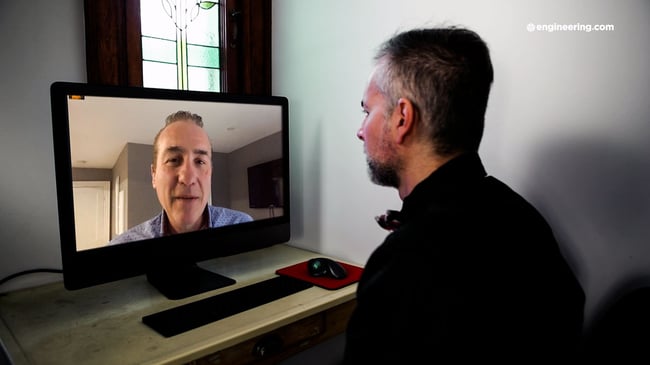Video Production is on Hold
After a solid 2019 in pipeline and sales, your company is about to release a new version of the product that revolutionized the engineering world. As part of your marketing strategy, you’ve engaged a production company to produce a testimonial video from your top customers.
Afterall, you know that video has a superpower: 87% of online marketers are currently using video content in their digital marketing strategies, and 90% of customers report that product videos help them make purchasing decisions.
And then, as you’re ready to go into production, coronavirus strikes; all productions are halted, cities and workplaces are on lockdown, and everyone’s working remotely from home. The video you meticulously planned for is now shelved for who-knows-when.
As a video producer that’s worked in production for over 18 years and now as Director of Video Communications here at engineering.com, this pause, albeit temporary, is not only unprecedented but disconcerting. Many video projects here were paused as we scrambled to figure out alternative solutions to our video production challenges: how do we tell our stories when on-location visits are now off the table?
A Solution to Every Problem
As the show must go on, so we searched for ways around the new barriers we suddenly faced. Since we cannot travel or go on-location anywhere, we brainstormed ways to leverage technology to produce a video and get our message out.
A video we recently produced is the solution to the challenge we faced. It worked for us. And it may for you as well.
We wanted to tell the timely story of a company called Eberspacher-Vecture (E-V), a manufacturer that makes electronic components for medical devices. Since the outbreak of the pandemic, E-V suddenly got an influx of queries and orders from global OEMs to supply parts for ventilators and powered respirators. They were even given a unique manufacturer number by the CDC, designating them as a priority distributor of their parts to the supply chain.
Typically, as we’d do for any video production, we’d visit the manufacturer at their facility. Being a time-sensitive story in the middle of a ventilator shortage, we conducted the interview with Angelo Catenaro, the company’s president, remotely via FaceTime, with both of us at home.

It’s the Same but Different
What do I mean? In some ways, it’s easier to conduct an interview remotely from home: I don’t have to lug around a ton of equipment; I don’t have to travel to a location; I don’t have to have an accompanying crew, and I can produce it faster.
But in other ways, it is harder: you have to rely on an internet connection that can easily buffer or cut-out; you can’t use high-end cameras to tape a professional-looking interview; you can’t light a subject at all (everyone needs to be lit); you don’t have a crew to help you out, and of course you lose the ability to connect with people directly as when you’re in the same room.
So how did our video turn out? See here:
As you can see, I was able to create a compelling story, even when working from home. Granted, I would have preferred a location shoot for a more polished end product – but considering the crisis, we believe we achieved our story-telling goal timely and effectively. Angelo also provided us with b-roll footage of the factory floor shot on his smartphone, which we then weaved into the interview to strengthen it – you can see everyone wearing protective masks.

This has also become the de facto standard practice among major broadcasters – CNN, BBC, CBC, MSNBC, to name a few – since the pandemic began. While the hosts of shows may be in the studio perfectly lit and in make-up, their guests are likely at home calling in from their laptop or desktop or even smartphone using any number of popular video-calling apps.
The key to successfully producing a video remotely is preparation - have your interview questions ready, and be sure to doing an initial test call with your subject either hours or days before the interview to iron out technical details. During the test call you can suggest where the subject should set up in a room for optimal lighting, make sure their home office looks tidy, and that they’re framed correctly in the shot and looking directly into their laptop’s camera.
We even helped our colleagues doing webinars from home improve the quality of their broadcasts by purchasing better webcams and microphones for clear audio, all in a bid to optimize the audience’s viewing and listening experience.
Is this a perfect solution? No. But until things get back to normal, this alternative workflow certainly works very well.
Let us know your thoughts on our approach for the Eberspacher-Vecture video. If you have a different process for shooting videos remotely or have thought of different ways to shoot video typically done on location, be sure to share. We would love to hear about your experience.
And, if you are struggling with resources or prefer to have an independent 3rd-party create your content, check our content services and connect with us today.
If have questions about our process described here, looking for advice, or need assistance in any way - feel free to reach out to us.



.png?width=1920&name=Video%20Call%20(1).png)



